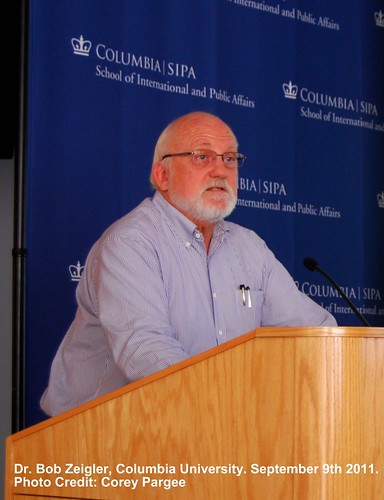On
Friday September 9th 2011, SIPA and the Earth Institute kicked off the
beginning of the semester with an enlightening presentation by Dr. Bob Zeigler,
Director of the International Rice Research Institute (IRRI), the world’s
leading center for the study of rice. The presentation marked this fall’s first
of a series of weekly Development Practitioner Seminars organized by SIPA’s MPA in Development Practice program. Speakers from around the world come to
Columbia University to share their work with the campus community.
The
timing for Dr. Zeigler’s presentation couldn’t be better. Recent figures from
the FAO estimate that 925 million people in the world are undernourished. With
50% of the world’s population eating rice as their main staple, ensuring that
there are enough cereal stocks for everyone is a global priority. The images of
the food riots of 2008 and the long lines of people waiting for food aid remind
us that the world needs more food and better and more comprehensive development
strategies.
But
the challenges to feed a famished world are multiple and complex. According to
Dr. Zeigler, the shrinking number of workers for the labor-intensive
cultivation of rice, combined with declining water levels for a crop that needs
swampy conditions to thrive, is making it difficult to keep production of this
precious staple above global demand. Moreover, as Asian cities and industries
continue to expand, land availability for rice fields is becoming scarcer.
As
we enjoy our sushi and arroz con leche, it’s
important to reflect on the progress made over the past 4 decades. IRRI is
credited for saving the lives of millions of people in the 60s and 70s during
the Asian Green Revolution. Due to the development of improved rice varieties
and advances in fertilizers, irrigation, and pest control methods, Asian
countries were able to nearly triple rice yields from 1.5 tons per hectare to 4
tons. The abundance of rice lowered consumer prices significantly, laying one
of the foundations for robust economic growth in what later became known as the
Asian Miracle. The impact was also felt in Latin America but to a lesser extent
in Africa.
Today’s
challenges are different from those in the 60’s. However, Dr. Zeigler stated
that technology and innovation continue to play an important role. Under his
leadership, the center is developing vanguard research with promising results.
One example is golden rice, a variety of the staple that contains
beta-carotene, a precursor of Vitamin A. With millions of children suffering
from micro-nutrient deficiencies, golden rice holds enormous potential to bring
Vitamin A into their diets. The center is also working hard to develop other
creative solutions. Such innovations
include the cultivation of rice varieties that can be grown in Africa, the
utilization of mobile technology to support poor farmers, and a reduction in
the amount of water required for rice cultivation, among many other projects.
One of the most exciting projects is the development of rice varieties that can
withstand extended submergence, an increasing hazard in the river deltas of
Asia, made worse by global warming.
After
decades of neglect, funding for agricultural research is starting to come back
to the donors’ agenda. Today, there is a strong scientific consensus about the
central role that agricultural research must play in addressing issues of
global food insecurity. But that scientific consensus must advance to a public
policy debate. This seminar was an excellent platform to inspire the next
generation of policy makers and development practitioners, and ensure that the
legacy of Dr. Zeigler, the IRRI, and the many other organizations working on
reducing poverty and hunger throughout the world, endures until every child
gets a plate of rice and vegetables for every meal.

